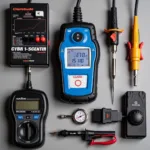Car diagnostic units have become indispensable tools for vehicle maintenance and repair. These sophisticated devices allow mechanics and car enthusiasts alike to delve into the intricate workings of modern cars, providing a window into the electronic brain that controls everything from engine performance to safety features.
What are Car Diagnostic Units and Why Do They Matter?
At its core, a car diagnostic unit is a device that interfaces with a vehicle’s onboard computer system, known as the Engine Control Unit (ECU). The ECU continuously monitors various sensors throughout the vehicle, collecting data on everything from engine speed and temperature to fuel pressure and emissions.
Car diagnostic units come into play when an issue arises with your vehicle. By connecting to the ECU, these units can read and interpret the diagnostic trouble codes (DTCs) stored by the system. These codes act like digital breadcrumbs, pointing mechanics towards the potential source of a problem.
Imagine this: your check engine light illuminates, causing a surge of mild panic. Instead of driving blindly to a mechanic and hoping for the best, a car diagnostic unit empowers you to understand the issue. It can tell you if it’s a minor sensor malfunction or a more serious engine problem, allowing you to make informed decisions about repairs.
Types of Car Diagnostic Units: From Basic to Professional
The market for car diagnostic units is vast and varied, catering to a wide range of users from DIY car owners to professional mechanics. Here’s a glimpse into the different types available:
1. Code Readers:
These entry-level units are designed to read and clear basic DTCs. They are generally affordable and user-friendly, making them suitable for car owners who want to perform basic diagnostics and troubleshoot simple issues.
2. OBD-II Scanners:
Building on the capabilities of code readers, OBD-II scanners offer a broader range of features. They can display live data streams from various sensors, allowing you to monitor engine performance in real time. Some models even provide access to manufacturer-specific codes, providing more in-depth diagnostic information.
3. Professional-Grade Diagnostic Tools:
As the name suggests, these units are designed for professional mechanics and automotive specialists. They offer advanced features such as bidirectional control, which allows users to interact with and control vehicle systems for testing and troubleshooting purposes. Laptop based car diagnostics often fall into this category, providing comprehensive diagnostic capabilities.
Choosing the Right Car Diagnostic Unit for Your Needs
With such a wide array of options, selecting the right car diagnostic unit can seem daunting. Here are some key factors to consider:
- Your Level of Expertise: Are you a DIY enthusiast or a seasoned mechanic? Your technical knowledge will influence the complexity of features you require.
- Vehicle Compatibility: Ensure the unit you choose is compatible with your vehicle’s make, model, and year. Pay attention to the communication protocols supported (e.g., OBD-II, CAN).
- Features and Functionality: Determine the specific features that align with your needs. Do you require live data streaming, bidirectional control, or access to manufacturer-specific codes?
- Budget: Prices for car diagnostic units can range significantly. Establish a budget beforehand to narrow down your options.
The Future of Car Diagnostics: Embracing Innovation
The automotive industry is in a constant state of evolution, and car diagnostic technology is no exception. Here are some emerging trends shaping the future of car diagnostics:
- Wireless Connectivity: Bluetooth and Wi-Fi enabled diagnostic units allow for seamless data transfer to smartphones and tablets, providing greater convenience and flexibility.
- Cloud-Based Diagnostics: Cloud platforms are emerging as powerful tools for storing and analyzing vehicle data, enabling predictive maintenance and remote diagnostics.
- Artificial Intelligence (AI): AI-powered diagnostic systems are being developed to analyze complex data patterns and provide more accurate and efficient fault detection.
Conclusion: Empowering Car Owners and Mechanics Alike
Car diagnostic units have revolutionized the way we approach vehicle maintenance and repair. From simple code readers to advanced professional tools, these devices provide invaluable insights into the health and performance of our vehicles. As technology continues to advance, we can expect car diagnostic units to become even more sophisticated, user-friendly, and indispensable for car owners and mechanics alike.

